
Chytridiomycosis is an infectious disease in amphibians, caused by the chytrid fungi Batrachochytrium dendrobatidis and Batrachochytrium salamandrivorans. Chytridiomycosis has been linked to dramatic population declines or extinctions of amphibian species in western North America, Central America, South America, eastern Australia, east Africa (Tanzania), and Dominica and Montserrat in the Caribbean. Much of the New World is also at risk of the disease arriving within the coming years. The fungus is capable of causing sporadic deaths in some amphibian populations and 100% mortality in others. No effective measure is known for control of the disease in wild populations. Various clinical signs are seen by individuals affected by the disease. A number of options are possible for controlling this disease-causing fungus, though none has proved to be feasible on a large scale. The disease has been proposed as a contributing factor to a global decline in amphibian populations that apparently has affected about 30% of the amphibian species of the world. Some research found evidence insufficient for linking chytrid fungi and chytridiomycosis to global amphibian declines, but more recent research establishes a connection and attributes the spread of the disease to its transmission through international trade routes into native ecosystems.
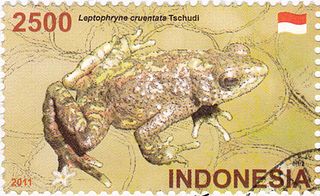
The bleeding toad, fire toad or Indonesian tree toad is a species of true toad in the amphibian family Bufonidae, endemic to Java, Indonesia. L. javanica was, formerly, synonymous with the bleeding toad prior to its description as a distinct species in 2018, although the degree of differentiation between these species is low. The bleeding toad is listed as a critically endangered species due to a drastic population decline. The factors behind this decline are unclear, but appear consistent with the global spread of chytrid fungus, a particularly lethal fungal spore for frogs and toads; once infected, the animals develop a condition known as chytridiomycosis before ultimately dying. it is estimated there are less than 250 individuals of the species.

Batrachochytrium dendrobatidis, also known as Bd or the amphibian chytrid fungus, is a fungus that causes the disease chytridiomycosis in amphibians.
Bromeliohyla, sometimes known as the bromeliad treefrogs, is a genus of frogs in the family Hylidae. This genus was erected in 2022 following a major revision of the Hylidae. The original two species in this genus were previously placed in the genus Hyla. It is the former Hyla bromeliacea group identified in a genetic study by Duellman (1970). Frogs in the genus are found in tropical southern Mexico, Belize, Guatemala, and northern Honduras.

The Panamanian golden frog, also known as Cerro Campana stubfoot toad and other names, is a species of toad endemic to Panama. Panamanian golden frogs inhabit the streams along the mountainous slopes of the Cordilleran cloud forests of west-central Panama. While the IUCN lists it as Critically Endangered, it may in fact have been extinct in the wild since 2007. Individuals have been collected for breeding in captivity in a bid to preserve the species. The alternative common name, Zetek's golden frog, and the epithet zeteki both commemorate the entomologist James Zetek.

Atelopus limosus, the limosa harlequin frog is an endangered species of toad in the family Bufonidae endemic to Panama. Its natural habitats are stream banks in tropical moist lowland forests and rivers of the Chagres watershed in central Panama.

Morelet's tree frog, also known as black-eyed leaf frog and popeye hyla, is a species of frog in the subfamily Phyllomedusinae. It is found in Belize, El Salvador, Guatemala, Honduras, and Mexico.

Triprion spinosus, also known as the spiny-headed tree frog, spiny-headed treefrog, spinyhead treefrog, coronated treefrog, and crowned hyla, is a species of frog in the family Hylidae. It has a spotty distribution in Panama, Costa Rica, Honduras, and southern Mexico. Previously in its own monotypic genus Anotheca Smith, 1939, it was transferred to the genus Triprion in 2018.
The greater bromeliad tree frog is a species of frog in the family Hylidae endemic to the mountains of central Veracruz and northern Oaxaca, Mexico. It has been observed between 450 and 1900 meters above sea level.
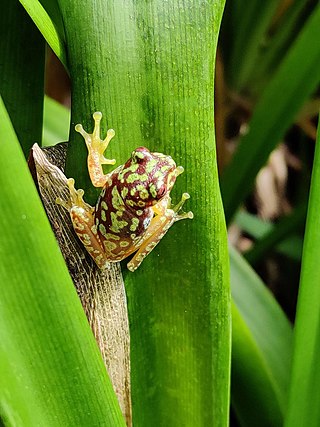
The Copan brook frog is a species of frog in the family Hylidae found in northeastern Guatemala and northwestern Honduras, specifically in the Sierra del Merendón, Sierra de Omoa, Sierra de Caral, and Sierra Espíritu Santo ranges. The colouring of this species is very distinctive and the specific name soralia comes from the resemblance of its markings to the vegetative structures on some crustose lichens.
Bocourt's tree frog, or Bocourt's treefrog, is a species of frog in the family Hylidae endemic to Guatemala and found on the mountains of the southern Alta Verapaz Department and Baja Verapaz Department. It is named after Marie Firmin Bocourt, a French zoologist and artist.

Agalychnis lemur, the lemur leaf frog or lemur frog, is a species of frog in the subfamily Phyllomedusinae. It is found in Costa Rica, Panama, and adjacent northwestern Colombia. It is classed as Critically Endangered and threatened by the fungal disease chytridiomycosis.
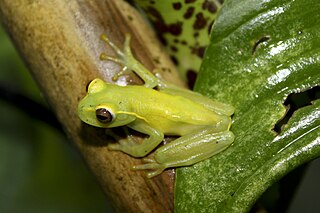
The La Loma tree frog is a species of frog in the family Hylidae found in Costa Rica, Panama, and expected but not confirmed in Colombia. Its natural habitats are tropical moist lowland and montane forests, with breeding taking place in streams. It is threatened by habitat loss and chytridiomycosis.

The green-eyed treefrog is a species of Australasian treefrog in the subfamily Pelodryadinae that occurs in the Wet Tropics of Australia.
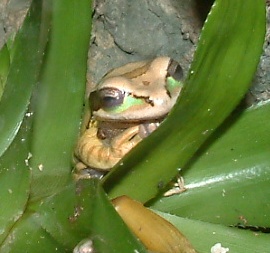
The blue-spotted Mexican tree frog is a species of frog in the family Hylidae found on the Atlantic slopes of southeastern Mexico, Belize, and Guatemala, between Jalapa de Díaz in Mexico and Sierra del Mico in Guatemala. Its natural habitats are humid mid-altitude and montane forests, and it can also occur in secondary forest. Breeding takes place in temporary pools and streams and in depressions in logs that fill up with water. It is threatened by habitat loss and, potentially, chytridiomycosis.

The Tarahumara frog is a species of frog in the family Ranidae found in Mexico and the southwestern United States, where it became regionally extinct in the early 1980s. Contributing factors include air pollution, chytridiomycosis and introduced species. Its natural habitats are streams and plunge pools in canyons in oak and pine-oak woodland, and foothill thorn scrub and tropical deciduous forest in the Pacific coast tropical area. Permanent water is necessary for reproduction.
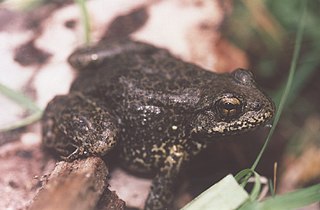
The Sierra Nevada yellow-legged frog or Sierra Nevada Mountain yellow-legged frog is a true frog endemic to the Sierra Nevada of California and Nevada in the United States. It was formerly considered Rana muscosa until a 2007 study elevated the more central and northern populations to full species status, restricting R. muscosa to the southern Sierra Nevada and southern California.
The bromeliad frog (Crossodactylodes) is a genus of frog in the family Leptodactylidae from the Atlantic Forest biome of eastern Brazil.
Bromeliohyla melacaena is a species of frogs in the family Hylidae. It is endemic to the Sierra de Omoa in northwest Honduras where it has been recorded from Cusuco National Park and Merendón Reserve.














